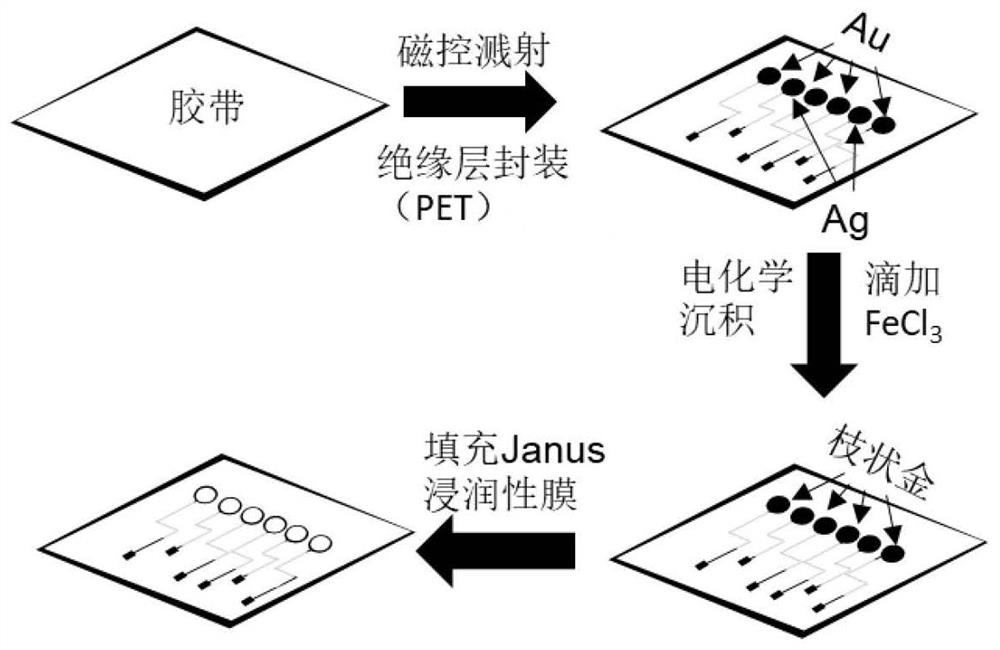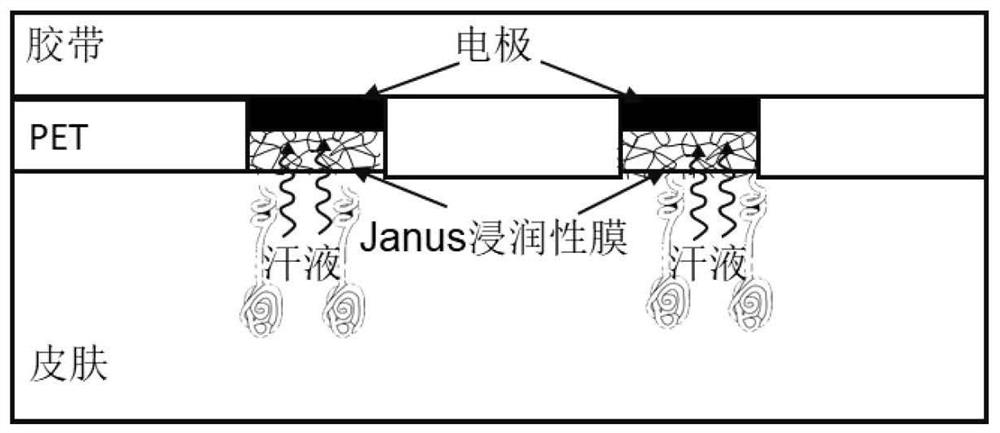A tape-based electrochemical sweat sensor
A sensor and electrochemical technology, applied in the field of tape-based electrochemical sweat sensors, can solve the problems of insufficient sensitivity in sweat collection and detection, and achieve the effects of low cost and convenient use.
- Summary
- Abstract
- Description
- Claims
- Application Information
AI Technical Summary
Problems solved by technology
Method used
Image
Examples
Embodiment 1
[0025] Example 1: Preparation of Tape-Based Electrode
[0026] Step 1: Electrode sputtering. like figure 1 As shown, a commercially available tape was carefully pasted on the back of the patterned mask with six circular micro-holes (including connecting circuits), and placed in a magnetron sputtering apparatus (gold sputtering), sputtering power 80w, For 10 min, a planar gold working electrode with a patterned array was obtained. Subsequently, the four micro-holes of the mask were sealed with adhesive tape, and then placed in the magnetron sputtering apparatus (silver sputtering) again, with a sputtering power of 80w and a sputtering time of 5min to obtain two silver reference electrodes.
[0027] Step 2: Insulation layer encapsulation. Take a piece of PET film, punch out the same patterned micro-holes as in step 1 with a hole punch, and carefully glue it to the adhesive layer, exposing only the six electrodes of the sputtering, covering the external transmission circuit. ...
Embodiment 2
[0030] Example 2: Preparation of Janus Wettable Film
[0031] Dissolve 5g of polyurethane (PU) particles in 45g of dimethylformamide (DMF) solution, stir magnetically for 2h until the PU particles are completely dissolved to obtain a 10wt% PU solution, which is then poured into the syringe of the electrospinning machine. Cut commercially available medical gauze into a 20×30cm strip and stick it on the receiving table about 15cm away from the syringe needle. Start the machine to start electrospinning, voltage 15kV, injection speed 2mL h- 1 , spinning time 5min. Put the gauze spun with PU in a fume hood for 24 hours until it is completely dry and set aside. The side spun with the PU film is the hydrophobic side, and the side not spun with the PU film is the hydrophilic side. When the hydrophobic side is attached to the skin, this Janus wettable membrane is able to adequately wick sweat away from the body surface, but not when the hydrophilic side is attached to the skin. The...
Embodiment 3
[0032] Embodiment 3: Glucose detection
[0033] Electrode modification: First make up to 1% chitosan solution, dissolve chitosan in 2% acetic acid, stir magnetically for 1 hour; then add graphene oxide (2 mg / mL) and ultrasonicate for 30 minutes to prepare chitosan / graphene oxide viscous solution; next, the chitosan / graphene oxide solution was mixed with glucose oxidase solution (10 mg / mL, PBS, pH=7.2) in a volume ratio of 2:1 to obtain glucose oxidase / chitosan Sugar / graphene oxide solution. 3 μL of glucose oxidase / chitosan / graphene oxide solution was added dropwise to the dendritic gold electrode, protected from light, and dried at 4° C. overnight to obtain a glucose sensor.
[0034] Detection: Take a clean test tube, add weighed anhydrous glucose and deionized water, and prepare glucose standard solutions with concentrations of 0 mM, 0.25 mM, 0.5 mM, 0.75 mM, 1 mM and 1.25 mM, respectively, for use. Then take another dry test tube to prepare a glucose test solution with a ...
PUM
 Login to View More
Login to View More Abstract
Description
Claims
Application Information
 Login to View More
Login to View More - R&D
- Intellectual Property
- Life Sciences
- Materials
- Tech Scout
- Unparalleled Data Quality
- Higher Quality Content
- 60% Fewer Hallucinations
Browse by: Latest US Patents, China's latest patents, Technical Efficacy Thesaurus, Application Domain, Technology Topic, Popular Technical Reports.
© 2025 PatSnap. All rights reserved.Legal|Privacy policy|Modern Slavery Act Transparency Statement|Sitemap|About US| Contact US: help@patsnap.com



